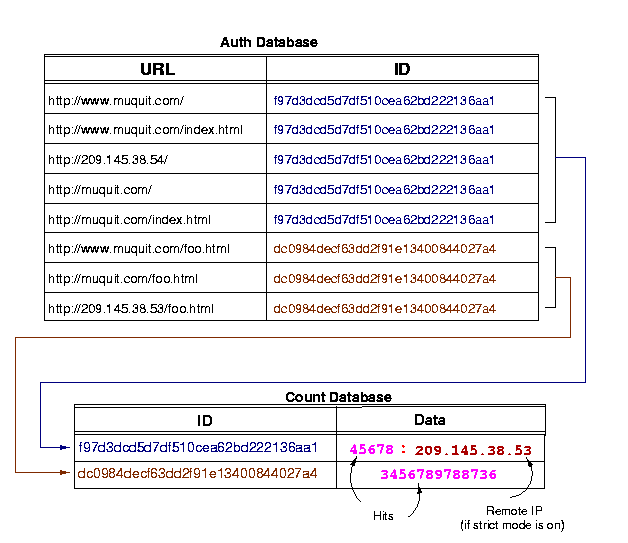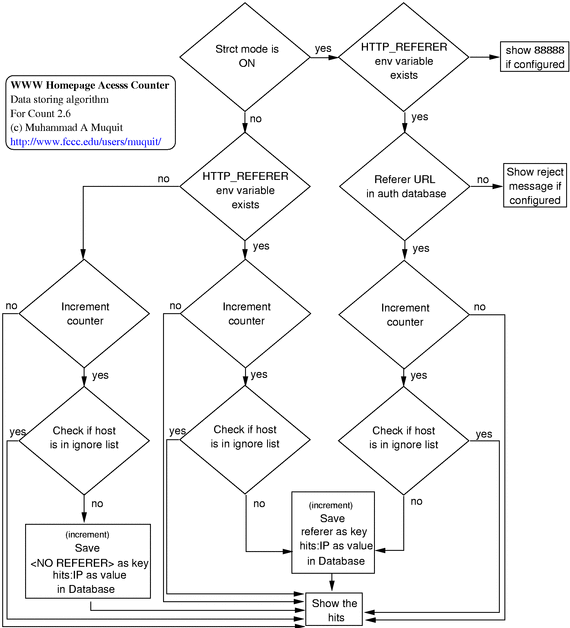



|
|
||

If a page can be accessed via different URL, the key for that pages in the auth database should be the same, otherwise the hits will be different if the pages are accessed differently.
Supporting databases
The counter programs supports any of the Berkeley db, GNU gdbm, sdbm and
ndbm databases. At compile time, the type of databases is decided and
compiled with. Please look at the following table to compare the features
of the various databases. It is clear that you should use Berkeley db.
|
The data is stored as key and value pair in the database. For authentication database, the key is the url of the page and vaue is a unique identifier ( MD5 (RSA Data Security, Inc. MD5 Message-Digest Algorithm) hash of the url) for the key. For the counter database, the key is the value from the authentication database (corresponding to the page url) and value is the hits:remote_ip.

Utilities for manipulating databases
The counter program comes with several utilities to manipulate the
counter database.
Usage: dumpdb db_file
255 250 250 snow 248 248 255 ghost white 248 248 255 GhostWhite 245 245 245 white smoke 245 245 245 WhiteSmoke 220 220 220 gainsboro 255 250 240 floral white 255 250 240 FloralWhite 253 245 230 old lace 253 245 230 OldLaceThe program make the name of the color the key and the red, green, blue components the value. It also converts all the name to lower case. Please look at the Directory Structure for the location of rgbdb.
Authentication database
Authentication database is a database of URL
WWW Homepage Access Counter uses. If strict_mode=yes in
count.cfg file, then anyone wants to put
a counter in a web page, the URL of the web page must be in this database.
If the URL is not in the auth database, then the user will get a message like
below:

Putting URL is authentication database is analogous to creating data files for the users in older versions of counter. It gives the administrators some control.
Authentication database can be manipulated by the program editdb or by the CGI program count_admin.pl.
Here's an example of using editdb, assuming you copied editdb somewhere in your path:
$ editdb /usr/local/etc/Counter/db/Authdb (Current database:Authdb) Command> dump <*> Locking database --------------------- http://localhost/tc/=>d255dbabb12267dd9da769d529fc474e http://localhost/=>c9db569cb388e160e4b86ca1ddff84d7 http://localhost/index.html.en=>c9db569cb388e160e4b86ca1ddff84d7 http://www.muquit.com/=>f97d3dcd5d7df510cea62bd222136aa1 http://localhost/tc/index.html=>d255dbabb12267dd9da769d529fc474e http://127.0.0.1/tc/index.html=>d255dbabb12267dd9da769d529fc474e http://localhost/tc/test.html=>5613f9e2ab0b292ca8a7b582f73e22bc http://127.0.0.1/tc/test.html=>5613f9e2ab0b292ca8a7b582f73e22bc --------------------- <*> Unocking database <->Lock released. (Current database:Authdb) Command> edit www <*> Locking database <*> Unocking database <->Lock released. 1 item matched. 1. http://www.muquit.com/=>f97d3dcd5d7df510cea62bd222136aa1 Enter the number to edit, Q to quit: 1 Edit Key (http://www.muquit.com/): http://muquit.com/ Edit Value (f97d3dcd5d7df510cea62bd222136aa1): <*> Locking database http://muquit.com/=>f97d3dcd5d7df510cea62bd222136aa1 * saved successfully! <*> Unocking database <->Lock released. (Current database:Authdb) Command> dump <*> Locking database --------------------- http://localhost/tc/=>d255dbabb12267dd9da769d529fc474e http://localhost/=>c9db569cb388e160e4b86ca1ddff84d7 http://localhost/index.html.en=>c9db569cb388e160e4b86ca1ddff84d7 http://www.muquit.com/=>f97d3dcd5d7df510cea62bd222136aa1 http://localhost/tc/index.html=>d255dbabb12267dd9da769d529fc474e http://127.0.0.1/tc/index.html=>d255dbabb12267dd9da769d529fc474e http://localhost/tc/test.html=>5613f9e2ab0b292ca8a7b582f73e22bc http://127.0.0.1/tc/test.html=>5613f9e2ab0b292ca8a7b582f73e22bc http://muquit.com/=>f97d3dcd5d7df510cea62bd222136aa1 --------------------- <*> Unocking database <->Lock released. (Current database:Authdb) Command> qIf you have lots of URLs to add, write them in a text file and load the file with editdb. The format of this file is:
URL=>ID
Here, URL is the key and the ID is the value.
Let put the following lines in a file called db.txt,
http://www.muquit.com/muquit/index.html=> http://www.muquit.com/muquit/=> http://muquit.com/muquit/=> http://muquit.com/muquit/index.html=> http://209.145.38.154/muquit/index.html=> http://209.145.38.154/index.html=>Note, the values are left empty intentionally. If the values are left empty, editdb will prompt for the value with a default. Below, we took only the first one as defualt (pressing Enter) and used this value for each of the other url, because all the urls are for the same page.
$ editdb -f db.txt foo.db Key=http://www.muquit.com/muquit/index.html Enter Value (3e38fe43ea71dfd2a671f245c15bbc9d): Key=http://www.muquit.com/muquit/ Enter Value (3f550961303f9bb899a896b5c45dc994): 3e38fe43ea71dfd2a671f245c15bbc9d Key=http://muquit.com/muquit/ Enter Value (165931a7b0c687223484be632881eb22): 3e38fe43ea71dfd2a671f245c15bbc9d Key=http://muquit.com/muquit/index.html Enter Value (e925c24eef64045a921b32051f17bfed): 3e38fe43ea71dfd2a671f245c15bbc9d Key=http://209.145.38.154/muquit/index.html Enter Value (78509821e809b24260490776762cd05e): 3e38fe43ea71dfd2a671f245c15bbc9d Key=http://209.145.38.154/index.html Enter Value (32c723d328a0f49bae453169a544fcc9): 3e38fe43ea71dfd2a671f245c15bbc9d <*> Locking database Add:http://www.muquit.com/muquit/index.html=>3e38fe43ea71dfd2a671f245c15bbc9d Add:http://www.muquit.com/muquit/=>3e38fe43ea71dfd2a671f245c15bbc9d Add:http://muquit.com/muquit/=>3e38fe43ea71dfd2a671f245c15bbc9d Add:http://muquit.com/muquit/index.html=>3e38fe43ea71dfd2a671f245c15bbc9d Add:http://209.145.38.154/muquit/index.html=>3e38fe43ea71dfd2a671f245c15bbc9d Add:http://209.145.38.154/index.html=>3e38fe43ea71dfd2a671f245c15bbc9d <*> Unocking database <->Lock released.You can use dumpdb to dump the database.
Advantages of using databases
<img src="/cgi-bin/Count.cgi">
Page will be figured out automatically.
Disadvantages of using databases
It's fixed now. (-mm, Sep-24-2000)
|
|
||


